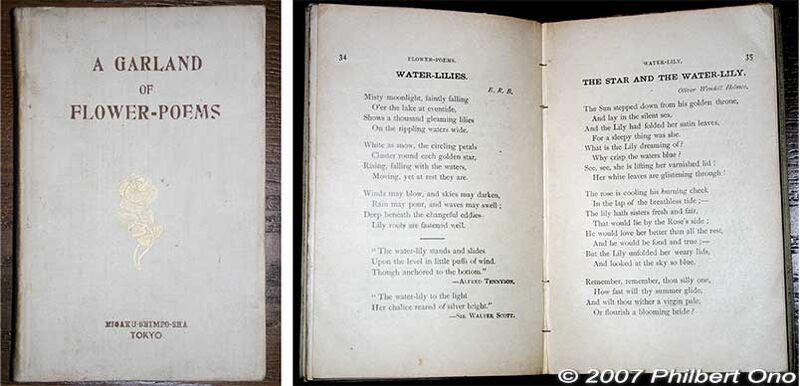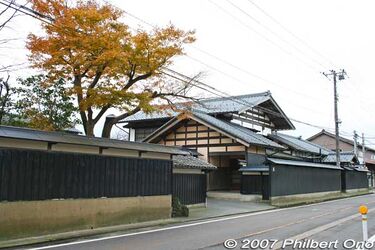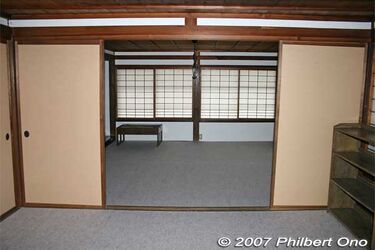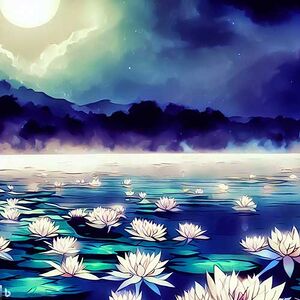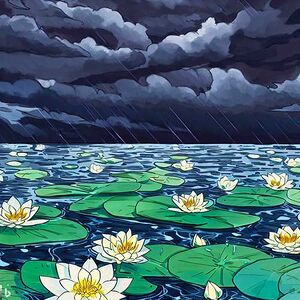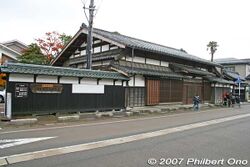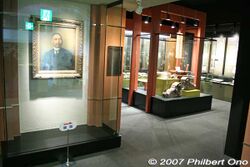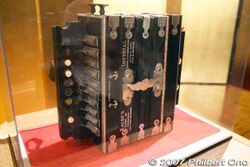Yoshida Chiaki
by Philbert Ono, updated June 17, 2023
Yoshida Chiaki (吉田 千秋) (1895.2.18-1919.2.24) was the writer and composer of a Japanese song called, Hitsuji-gusa (ひつじぐさ) or Water Lilies. This song's melody was largely adopted as the melody for the famous song, Biwako Shuko no Uta (Lake Biwa Rowing Song 琵琶湖周航の歌) written by Oguchi Taro in 1917. (In the video above, Hitsuji-gusa is sung by the Koai Gassho chorus (小合合唱の会) at Yoshida's birth home in Niitsu, Niigata on the anniversary of his death in Feb. 2013.)
Yoshida Chiaki was from Ojika (大鹿) (now part of Niigata city) in Niigata Prefecture. His father was the famous geographer Yoshida Togo (1864-1918) (吉田東伍) who spent 13 years compiling an encyclopedia of Japanese place names. The Yoshida Togo Memorial Museum in Agano, Niigata is dedicated to Chiaki's father. The museum also has a small exhibit about second son Chiaki.
Ongaku-kai music magazine
In 1915, Yoshida Chiaki's Hitsuji-gusa song was published in the Aug. issue of a music magazine called Ongaku-kai (音楽界). Yoshida's song was actually his Japanese translation of a late 19th century British children's song called Water Lilies (see lyrics below). The Japanese lyrics closely match the English lyrics in meaning, but Chiaki's melody is totally different from the melody of the British song. He composed his own melody to suit his Japanese lyrics. The melody was like a Christian hymn, evidence that Yoshida was influenced by his independent studies of Christianity. The lyrics have Buddhist overtones, so it is interesting that the song is matched with a Christian hymn.
The Biwako Shuko no Uta lyrics were written primarily by college student Oguchi Taro in 1917. He was a member of a collegiate rowing club in Kyoto which had a tradition of rowing around Lake Biwa in Shiga Prefecture every summer. One rowing club member apparently knew about Yoshida's Hitsuji-gusa song and thought the melody would go well with Oguchi's lyrics. Yoshida's melody was adapted to Oguchi's lyrics with very little modification and it stuck. Biwako Shuko no Uta got very popular within the school and eventually became nationally famous even today. Yoshida never knew about his melody being used in Biwako Shuko no Uta.
Yoshida Chiaki Biography
Yoshida Chiaki was born in Ojika (大鹿 now part of Niigata city) in 1895 and moved to Tokyo with his father at age 2. At age 6 in 1901, he went back to Ojika to attend elementary school. In 1912 at age 17, he went to high school and later entered Tokyo University of Agriculture in Tokyo. In 1914, he dropped out of college due to illness and returned to Ojika in 1915. While he was terminally ill in Ojika, he composed the Hitsuji-gusa song. In 1919, he passed away at home at age 24 from tuberculosis. He never met the songwriter Oguchi Taro who also died in his 20s.
Like Oguchi Taro, Yoshida was an extremely talented and academic young lad. He was interested in a wide variety of subjects such as foreign languages, geography, zoology, botany, astronomy, and natural history. At age 11, he started writing a series of homemade and handwritten magazines about astronomy, animal, plant, and bird taxonomy accompanied by precise illustrations that he drew. His interest in living things started with animals and extended to plants. He wrote and illustrated his observations. He was a talented artist. At his birth home, he had a small garden where he grew flowers, some of which are still there. He kept a diary on growing his flowers.
When he went to school in Tokyo, he was exposed to English which sparked his study of seven languages, including Esperanto. He joined a British pen pal club and corresponded with many pen pals overseas. This made him interested in world geography as well as foreign folk stories such as Greek mythology. He also studied the romanization of Japanese. Yet, he still cherished the Japanese language and composed waka poetry. In his final months, he even researched Niigata Echigo dialects. He left behind quite a few notebooks, etc.
After he dropped out of college due to illness, he was hospitalized in Chigasaki, Kanagawa Prefecture. The hospital director got him interested in Christianity that led to an interest in music, such as in hymns. After returning to his hometown of Ojika, he joined a Christian group and was a leader for their hymns. He eventually composed songs and lyrics which he submitted to music magazines.
When he was 18, he translated the lyrics of the British Water Lilies song into Japanese. Later he composed a melody for his Japanese lyrics to create his Hitsuji-gusa song that was submitted to the Ongaku-kai music magazine when he was 20 years old. The magazine published his song on the first page.
When he was 23, he went to Tokyo for treatment and was shocked to learn that there was nothing more they could do for his incurable lung condition. He returned to Ojika and told his family, "If I have to die, I'd rather die in Ojika. I have come home to die." To prevent the transmission of his disease, he remained in his 2nd floor room at home and avoided direct contact with family members.
Being about holding firm in times of adversity, the Hitsuji-gusa song gave him solace and strength. He died on Feb. 24, 1919, a few days after his 24th birthday. Coincidentally, Chiaki was born in the Year of the Ram (hitsuji), and died in the Year of the Ram. Although hitsuji-gusa means water lilies, it literally means "ram grass." In the Oriental zodiac, the ram represents the time of 2:00 pm when the water lily would bloom. That's how the flower got its Japanese name, even though water lilies actually bloom in the morning and wither in the evening.
Hitsuji-gusa plus Biwako Shuko no Uta
Meanwhile, Biwako Shuko no Uta eventually became the rowing club's official song and one of Kyoto University's official songs. Needless to say, it also became Shiga Prefecture's most famous and beloved song, even today. In 1971, the song gained national prominence when singer Kato Tokiko scored a major hit with her version. At the time, it was still unknown as to who composed the melody. Interested parties started investigating. It wasn't easy to find out what they wanted to know. Around 1975, the first big break came when it was found that the melody came from a song called, Hitsuji-gusa. It took five years before they found out that Hitsuji-gusa was composed by a Yoshida Chiaki (when they found his song in the Ongaku-kai magazine). But nobody knew who he was and he remained a mystery for over 10 years.
'The search for Chiaki'
In 1993, for the 75th anniversary of Biwako Shuko no Uta, Imazu town in western Shiga Prefecture put out a newspaper article in Niigata with a plea for any information about Yoshida Chiaki. All they knew was that Chiaki moved from Tokyo to Niigata. By coincidence, a researcher named Hatano Hiroshi (旗野博) studying Chiaki's famous father, Yoshida Togo, saw the article and was sure that it was Togo's second son Chiaki. For the first time, and after over 20 years of investigations, the composer of the melody of Biwako Shuko no Uta was finally identified.
In fall 2001, a grassroots organization called, Chiaki no Kai (「ちあき」の会 Chiaki Association) was formed in Niigata in honor of Yoshida Chiaki and his legacy. They research, catalog and preserve Chiaki's documents and materials, help to educate people about Yoshida Chiaki and the Hitsuji-gusa song, hold cultural activities, and issue newsletters. They also hold an annual memorial gathering at the Yoshida home in Ojika on the anniversary of Chiaki's death in Feb.
Chiaki's childhood home
In 2007, I visited Yoshida Chiaki's home in Ojika for the first time. The large, Japanese-style house where Chiaki lived is still there, now occupied by his soft-spoken niece, Yoshida Yuki (吉田ゆき), the daughter of Chiaki's younger brother Fuyuzo (冬蔵) who was a college professor in Niigata. Chiaki had an older brother and sister and a younger brother (Fuyuzo) and sister. His niece allowed me to see the house and the room on the second floor where Chiaki lived during his final months. She also kindly showed me a copy of the Ongaku-kai magazine and a few of Chiaki's books, including one that had the original British Water Lilies song. (Photos below.) Although the house is not open to the public, special local events are held there on occasion.
Hitsuji-gusa ひつじぐさ
Written and composed by Yoshida Chiaki 吉田千秋
There are three verses. The lyrics on the left column are based on the original writing, the lyrics in the middle includes kanji characters which make it easier to understand if you can read Japanese. The lyrics in the right column is a romanization. The Japanese lyrics are a close translation of the original English song Water Lilies whose lyrics are also shown below. Perhaps you should read the Water Lilies lyrics first (scroll down)
|
1 |
1 (Kanji) |
1 (Romanized) |
|
2 |
2 (Kanji) |
2 (Romanized) |
|
3 |
3 (Kanji) |
3 (Romanized) |
Essential Vocabulary
Verse 1
おぼろ misty, foggy
かすかに faintly
面 water surface
数知らぬ countless
Verse 2
雪かとまがふ
蘂 stamen, which is the yellow part of the flower surrounded by petals
揺るげども being shaken (by the waves)
花の心 literally "heart of the flower," apparently a metaphoric reference to the entire flower (petals + stamen)
波立たず holding fast against the waves
Verse 3
さりながら while being subjected to (rain and waves)
徒波 fleeting (always changing) waves
萌えいでたりぬ
Water Lilies
By E.R.B. (Education & Resettlement Bureau)
Misty moonlight, faintly falling
O'er the lake at eventide,
Shows a thousand gleaming lilies
On the rippling waters wide.
White as snow, the circling petals
Cluster round each golden star,
Rising, falling with the waters,
Moving, yet at rest they are.
Winds may blow, and skies may darken,
Rain may pour, and waves may swell;
Deep beneath the changeful eddies
Lily roots fastened well.
Yoshida Togo Memorial Museum
Related Articles
- Lake Biwa Rowing Song
- Oguchi Taro
- Biwako Shuko no Uta - In Japanese
- Lake Biwa Rowing Song Museum (Biwako Shuko no Uta Shiryokan) - Song museum in Imazu, Shiga.
- Shiga Prefecture
- History of Shiga Prefecture
Bibliography
- 「琵琶湖周航の歌 〜千秋と太郎の出会いの日〜」監修/飯田忠義、今津町、2004年3月31日出版

